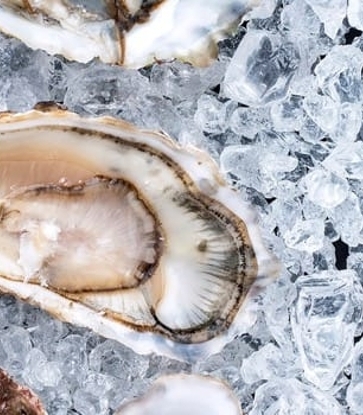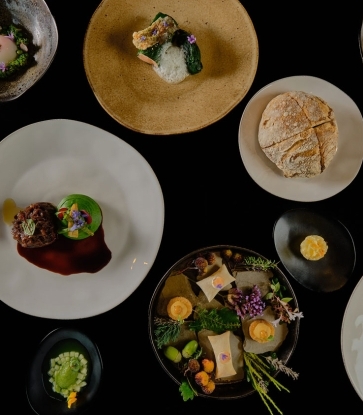One of the most vibrant food trends to catch on in 2017 was purple produce. Acai bowls and black rice risotto fought for social media screen time with purple sweet potato puree and roasted purple cauliflower.
Are purple foods worth the hype though?
Absolutely. Ingredients such as purple cauliflower, black rice, acai, purple corn and elderberry are rich in anthocyanin, which comes with antioxidant properties to fight heart disease, lower inflammation, and prevent aging.
With so much health benefits at stake, we’ve selected five purple foods you need to stock in the pantry.

Purple Cauliflower
The color purple has been associated with prestigious status since Julius Caesar. As gastronomes look for the next food nobility filled with nutritious substances, enter the “violet queen.” Beyond the beautiful hue, this Mediterranean cauliflower boasts sweeter flavors than its white and green counterparts. The antioxidants in the vegetable help combat diabetes and heart disease. Its finer fiber structure also means that it can be digested more easily.Cauliflower rice is an easy (and fashionable) way to work the “violet queen” into your daily meals. It only takes 10 minutes from blitzing a head to serving the cooked “rice” on the table. High in Vitamin C and low in calories, it’s the dream carb replacement.
Purple Bread
This curious invention from the bakery has yet to hit the market but has already stimulated discussions. With a high glycemic index, white bread often leads to higher blood sugar levels. It’s also seen as a high energy food, something not particularly welcomed by individuals on weight control. Food scientist Zhou Weibiao at the National University of Singapore took on the task to create a healthier alternative—his solution includes anthocyanins from black rice, which adds antioxidants and the eye-catching purple shade to the baked good. Digested 20% slower in the human body, the purple bread potentially makes us eat less and feel better on the scale.
Purple Yam
Purple yams (or, ube) have quickly grown into the national food of the Philippines, being used locally on various desserts. This tradition caught on in North America, turning into an online sensation. After the success of the ube donuts sold for $40 per dozen, New York City-based Manila Social Club launched a famous edition coated in gold with Champagne icing and yam mousse filling to the tune of $100 each. Packing a vibrant shade and floral notes alongside the antioxidant banner, one can expect the Filipino favorite to stay on the gastronomic radar for a while.
Acai
The Brazilian berry could well be the Cinderella of all foods—hailing from the Amazonian rainforest, it became the hot item at cafés frequented by Hollywood superstars overnight. The main reason behind it is its antioxidant content, eight times the amount found in blueberries and potentially 30 times that of red wine—no wonder it captured the attention of the youth-obsessed glitterati. The berry also contains oleic acid which reduces blood pressure and aids fat-burning, in addition to iron, Vitamin A, dietary fiber and 19 kinds of amino acids. As a result, we find our food stores populated with products made with acai. But to make the most of its benefits, it’s best to pay attention to the production and compositional details of the specific item.
Pomegranate
Pomegranate tips towards the purple-red in the spectrum color, and has been championed by cultures across the world. For instance, it was used by ancient Greeks and Indians to cure female hormonal issues. In addition to this, Traditional Chinese Medicine (TCM) says the fruit has the ability to tackle thirst, blood spillage and diarrhea. Beyond the curative functions, it was a sign of prosperity to ancient Egyptians and a natural aphrodisiac according to modern medicinal studies.
The list doesn’t end here. Pomegranate carries 60% higher potassium content than the banana, three times the antioxidants of green tea, and more lycopene than a tomato or watermelon. If you wish to strengthen your bones and muscles, prevent artery blockage and heart diseases, or repair DNA damage, pomegranate is the food for you. As brilliant as the fruit is on paper—and like any other piece of produce—it should be eaten with consideration of any personal body condition. Those with constipation and a bad digestive system need to watch their intake or avoid it altogether.

While purple foods are, indeed, all the rage, TCM specialists and nutritionists recommend an ideal diet with foods of the entire rainbow. Enrich your color palette with the ingredients below:
Green
Organ it controls in TCM: Liver
Foods: Leafy greens, bamboo shoot, green pepper, celery, cucumber, green bean, mung bean, green papaya, fig, kiwi fruit
Nutrients commonly found: Vitamin C, folate, dietary fiber
Health benefits: Improves digestion, metabolism, anti-oxidation, detoxification and relieves “heat” in liver
Red
Organ it controls in TCM: Heart
Foods: Beef, pork, lamb, animal liver, red bell pepper, red bean, carrot, tomato, hawthorn, red apple, watermelon, grape, strawberry, cherry
Nutrients commonly found: Vitamin A, carotene, lycopene, iron, protein
Health benefits: Prevents anemia (from iron deficiency) and flu, removes free radicals, acts as an anti-inflammatory, strengthens lymphatic system
Yellow
Organ it controls in TCM: Spleen
Foods: Egg yolk, grains, lotus seed, soy bean, corn, sweet potato, pumpkin, papaya, yellow bell pepper, bean sprouts, Asian pear, banana, starfruit, citrus
Nutrients commonly found: Vitamin A & C, carotenoid, carbohydrate
Health benefits: Prevents gastritis, improves concentration, anti-oxidation and anti-aging, relieves chronic digestive disease, “heat” in spleen and stomach
White
Organ it controls in TCM: Lung
Nutrients commonly found: Protein, calcium, carbohydrate
Foods: Ginseng, chicken, fish, nuts, white grains, Chinese yam, lily, ginger, potato, white cauliflower, turnip, winter melon, onion, white wood ear fungus, coconut, milk, tofu, yogurt
Health benefits: Improves respiratory system and bone structure, repairs cells, prevents fatty liver disease and hyperlipidemia
Black
Organ it controls in TCM: Kidney
Nutrients commonly found: Anthocyanin, iron, calcium, selenium, zinc
Foods: Black sesame, black bean, eggplant, black date, konbu, shiitake mushroom, black wood ear fungus, chestnut, black grape, dried black plum
Health benefits: Improves blood circulation, prevents atherosclerosis and ischemic heart disease, prevents hair loss and whitening, anti-aging, removes free radicals, improves reproductive and excretory system





















